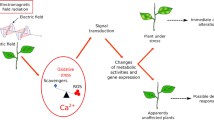Abstract
This chapter describes techniques of plant protection using electromagnetic (EM) waves. EM protection depends on the nature of the interaction between EM waves and the target plants, soil, devastating insects and diseases. The examination of each factor affecting this interaction is thus essential since it will set up the limits and possibilities of applications for these EM techniques. First, we will describe the main characteristics of EM waves; then we will analyse their interaction with plants, the soil and the insects.
Access this chapter
Tax calculation will be finalised at checkout
Purchases are for personal use only
Preview
Unable to display preview. Download preview PDF.
Similar content being viewed by others
References
Arul J., Mercier J., Charles M.T., Baka M., Benhamou N., (1996). Utilisation des UV pour réduire les maladies post-récolte chez les carottes et d’autres produits horticoles. Symposium La lutte physique en protection des plantes, SPPQ, Québec, 6–7 Juin 1996.
Baden H.P., Kollias N., Anderson R.R., Hopkins T., Raftery L., (1996). Drosophila melanogaster larvae detect low doses of UVC radiation as manifested by a writhing response. Arch. Insect Biochem. Physiol. 32: 187–196.
Banks H.J., (1976). Physical control of insects — recent developments. J. Aust. Entomol. Soc. 15: 89–100.
Bonn F., Rochon G., (1992). Précis de Télédétection, Vol. 1, Presses de l’Université du Québec, Québec, 485 p.
Bruce W.A., Street M.W., Semper A.R.C., Fulk D., (1982). Detection of hidden insect infestations in wheat by infrared carbon dioxide gas analysis. Agriculture Research Service, no. AAT S-26, USDA, Washington DC.
Culotta E., (1994). UV- B effects: Bad for insect larvae means good for algae. Science, 265: 30.
Fisher E., McMechan G.A., Annan A.P., (1994). Acquisition and processing of wide-aperture groundpenetrating radar data. Geophysics 57: 495–504.
Flint S.D., Caldwell M.M., (1996). Scaling plant ultraviolet responses from laboratory action spectra to field spectral weighting factors. J. Plant Physiol. 148: 101–114.
Gausman H. W., (1985). Plant leaf optical properties in visible and near-infrared light, Lubbock, Texas: Texas Tech Press, p.78.
Hecht E., (1987). Optics, 2nd ed., Addison-Wesley, Mass., 640 p..
Krieg A., (1975). Photoprotection against inactivation of Bacillus thuringiensis spores by ultraviolet light. J. Invert. Pathol. 25: 267–268.
Nelson S.O., (1972). Insect-control possibilities of electromagnetic energy. Cereal Science Today 17; 377–387.
Nelson S.O., (1985). RF and microwave energy for potential agricultural applications. J. Microwave Power 20: 65–70.
New York Times, (1995). Analysis of tree bark shows global spread of insecticides. Oct. 10, 1995, Sec: C, p:4, col: 1.
Olszyk D., Dai Q., Teng P., Leung H., Luo Y., Peng S.B., (1996). UV-B Effects on Crop: Response of the Irrigated Rice Ecosystem. J. Plant Physiol. 148: 26–34.
Philbrick C.T., (1984). Comments on the use of microwave as a method of herbarium insect control: possible drawbacks, Taxon 33: 73–76.
Rosenberg U., Bögl W., (1987). Microwave Pasteurization, Sterilization, Blanching, and Pest Control in the Food Industry. Food Technology, June 1987, p. 93–97.
Schulzowà T., (1996). Photoinhibition in situ in Norway Spruce. J. Plant Physiol. 148: 129–134.
Stuben M., (1973). Studies on the influence of electronic flashes on the mortality and fertility of Musca domestica. Z. Ang. Entomol. 74: 35.
Thayer D.W., (1985). Application of Radiant Energy in Pest Management. Cereal Foods World, 30: 714–721.
Ulaby F., Moore K., Fung A., (1982). Microwave remote sensing — active and passive. Vol II, Artech.
Van Kooij J.G. (1982). International aspects of food irradiation, p. 84–97 in Food irradiation Now, M. Nijkoof et W. Junk Publishers, La Haye, Pays Bas, 157 p
Yang H.K., Lockwood J., Tompkins W.A..F. (1983). Effects of microwave exposure on the hamster immune system. Bioelectromagnetics 4: 123.
Editor information
Editors and Affiliations
Rights and permissions
Copyright information
© 2001 Springer-Verlag Berlin Heidelberg
About this chapter
Cite this chapter
Lewandowski, J. (2001). Electromagnetic Radiation for Plant Protection. In: Vincent, C., Panneton, B., Fleurat-Lessard, F. (eds) Physical Control Methods in Plant Protection. Springer, Berlin, Heidelberg. https://doi.org/10.1007/978-3-662-04584-8_7
Download citation
DOI: https://doi.org/10.1007/978-3-662-04584-8_7
Publisher Name: Springer, Berlin, Heidelberg
Print ISBN: 978-3-662-04586-2
Online ISBN: 978-3-662-04584-8
eBook Packages: Springer Book Archive




